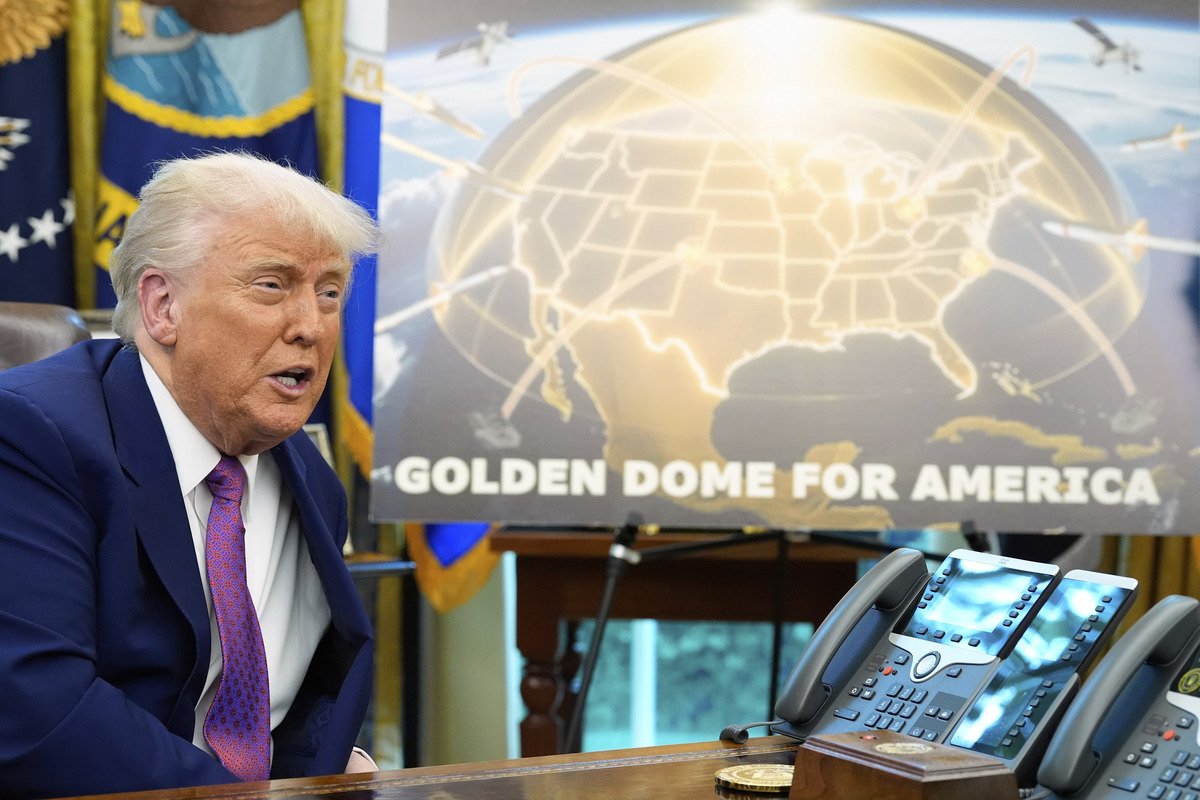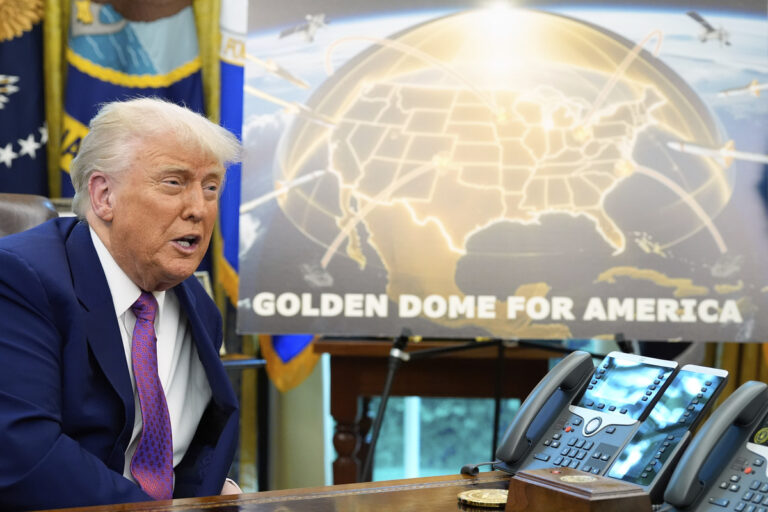President Donald Trump increased the proposed price for Canada’s participation in the U.S. Golden Dome missile defense system.
“They want to be in,” Trump told reporters aboard Air Force One on Monday. “Seventy-one billion they’re going to pay.”
The new price tag is $10 billion higher than Trump’s earlier public demand for Canadian entry into the program. Newsweek has contacted the White House and Canada’s prime ministerial office via email for comment. Canada’s defense ministry directed questions to Prime Minister Mark Carney’s office.

AP Photo/Alex Brandon
Why It Matters
Trump revealed initial plans for the Golden Dome missile defense system earlier this year, touting the design as “state of the art.”
The president said the Golden Dome would be up and running by the end of his administration, shielding North America from “next-generation” threats like ballistic, cruise and hypersonic missiles. According to Defense One, a defense official said in March that it would take at least five to seven years to develop the Golden Dome’s space-based weapons.
Russia, China and North Korea have heavily invested in their militaries, including in long-range weapons.
What To Know
Trump said Canada had requested to be part of the development of the Golden Dome. Canada and the U.S. already work together under the North American Aerospace Defense Command (NORAD) to detect incoming threats to North America.
Trump said Canada would “have to pay a lot of money” for the Golden Dome, indicating Washington would make a separate deal for the missile defense system with Ottawa in addition to a trade agreement.
Trump said access to the Golden Dome would come with a $61 billion price tag for Canada “if they remain a separate, but unequal” country. It would be free if Canada became the 51st state, Trump said.
In response to Trump’s earlier remarks, Canadian Ambassador to the United Nations Bob Rae likened the terms to a “protection racket” and reaffirmed Canada’s sovereignty.
Canada has railed against Trump’s repeated reference to it becoming part of America. Carney, who won re-election in April on Canadian infuriation about Trump’s overtures toward Canada, said last month it was positive to “have protections in place for Canadians” but added: “There will be discussions that could have an impact on Canada, but Canada wouldn’t be a part of them.”
But Canada brings something to the table with nearly 4 million square miles of lines of sight for U.S. sensors to defend against missiles that China and Russia are developing to fly over the North Pole, which is a gap in U.S. air defenses, Politico reported last month.
The Golden Dome is loosely modeled on Israel’s famed short-range Iron Dome air defense system. The Iron Dome, however, is designed to intercept the kind of attacks common against Israel, unlike long-range missiles able to cross continents.
As it stands, the U.S. does not have a joined-up system for intercepting large-scale intercontinental ballistic missile (ICBM) strikes launched from Russia or China, although it would be able to take out the relatively small number of missiles that North Korea could fire at the U.S.
The U.S. currently has 44 ground-based interceptors (GBIs) deployed around the country—40 are in silos in Alaska, with four at the Vandenberg Air Force Base in California as part of its Ground-Based Midcourse Defense system.
Around 2028, the Pentagon will add 20 next generation interceptors, or NGIs, to the 44 GBIs. Whatever is missed by these interceptors would likely fall to the U.S. Navy’s Aegis system.
Trump has framed the Golden Dome system as the end result of a program kicked off by President Ronald Reagan in the 1980s, popularly known as “Star Wars.” The Golden Dome will use space-based sensors and interceptors to knock out missiles “even if they are launched from space,” Trump said.
The Golden Dome, using space-based weapons to strike targets closer to the ground, “will be transformational,” the Council on Geostrategy, a U.K.-based think tank, said in a paper published last month. It said the missile shield will have “far-reaching strategic consequences.”
The Congressional Budget Office said in May that the bill for the space-based part of the Golden Dome could come in at $542 billion over the next two decades. The Trump administration said the estimated price tag stands at about $175 billion.
An initial $25 billion has been earmarked in next year’s budget.
What People Are Saying
General Chance Saltzman, head of the U.S. Space Force, told lawmakers at a congressional hearing last month: [The space-based weapons envisioned for the Golden Dome] “represent new and emerging requirements for missions that have never before been accomplished by military space organizations.”
Mao Ning, a spokeswoman for the Chinese Foreign Ministry, during a press briefing: “This highly offensive system violates the principle of peaceful use of outer space. It will exacerbate the risk of turning outer space into a battlefield and starting an arms race and shake the international security and arms control system.”
Glen VanHerck, a retired Air Force general and former head of the U.S. Northern Command, told Politico in May: “What Canada really brings is terrain. If we can position, or Canada positions, over-the-horizon radars further north in the Arctic, that dramatically increases the United States and Canada’s ability to see over the pole into Russia, into China and other places.”
What Happens Next
The Pentagon and U.S. Northern Command are in the process of drafting an initial capabilities document, according to a U.S. official.
This article contains reporting by The Associated Press.


